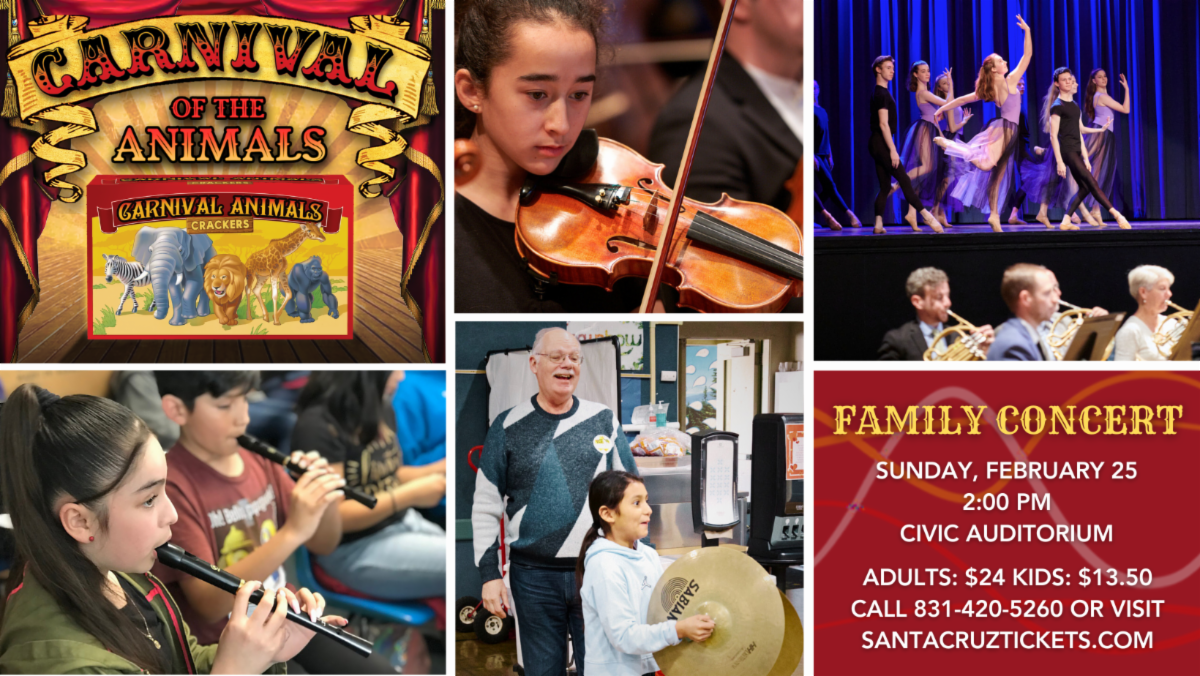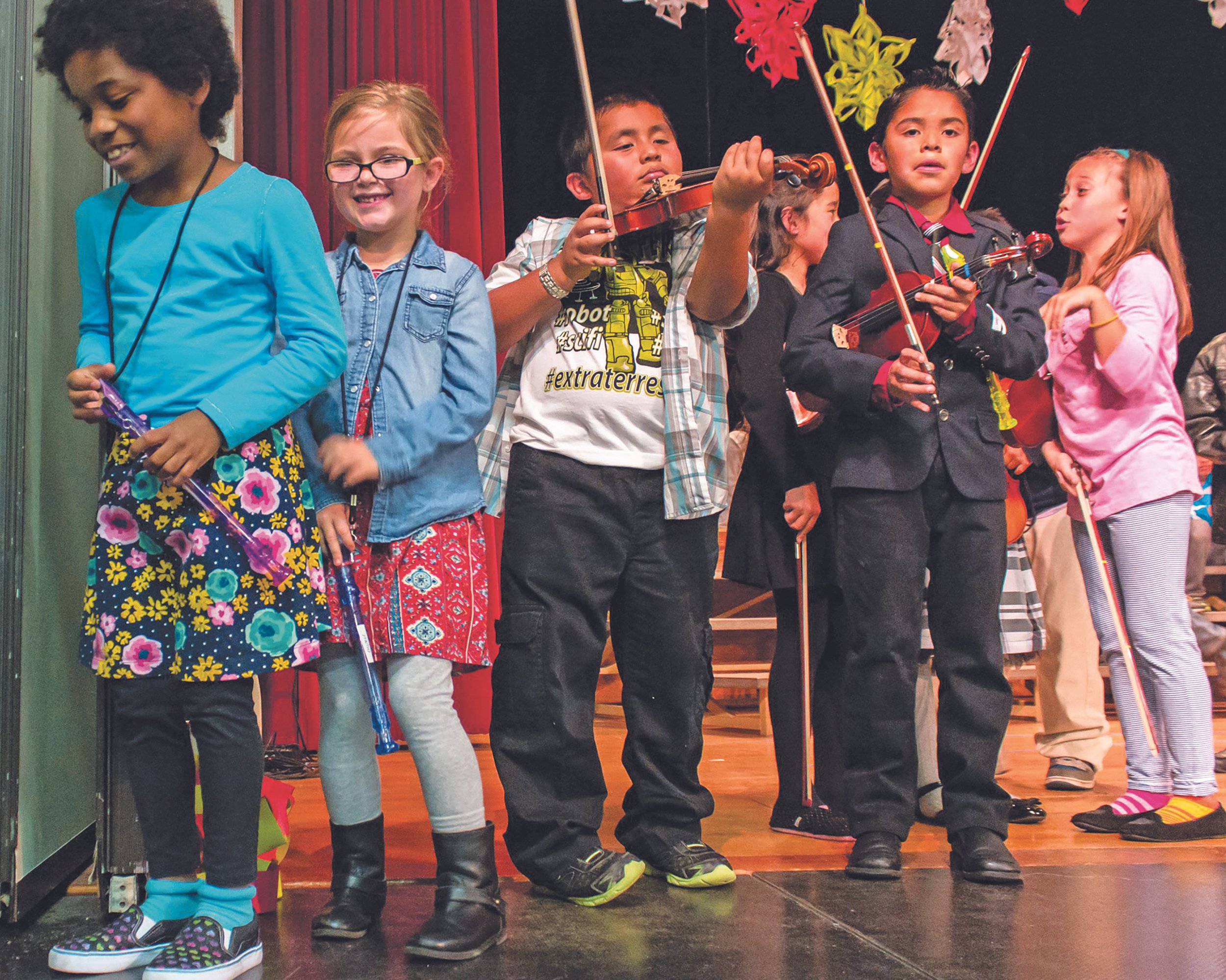Professor Martin Gaskell
The Santa Cruz Symphony was in a festive mood this last weekend for concerts that included some very demanding virtuoso playing by the orchestra. The penultimate pair of concerts of the 2023-24 regular season opened and closed with music inspired by festivals.
The concert began with California composer José González Granero’s joyous 2017 Matsuri Overture. This was inspired by Japanese festivals (Matsuri means “Festival” in Japanese), but this lively overture could fit a wide range of festivals around the world. It is very well composed from its overall structure down to small-scale details and the orchestration is superb. Granero packs just the right amount of material into a running time of a little under six minutes.
The overture starts with an energetic orchestral tutti that, not knowing otherwise, one could well believe had come from Stravinsky’s Petrushka in the second half of the concert. However, the music quickly moves on to a cheerful pentatonic melody for the woodwinds. We get a counter melody for the horns, lively passagework for the violins, a broad theme for the strings and woodwinds, moments of calm, exciting crescendi, and, towards the end, a chorale for the brass. Granero describes himself as a Spanish-American composer and the overture is not particularly Japanese. Yes, there are pentatonic melodies, but pentatonic melodies are common around the world (think of “Amazing Grace,” for example.) However, one specifically Japanese touch in the performance was the use of large taiko drums. Maestro Daniel Steward chose to have these placed up front on the left and right sides of the orchestra to give an antiphonal effect. The sound of large taiko drum can reputedly rival the decibel level of a jet engine and be heard many kilometers away, but Maestro Stewart was careful not to allow the taiko drums to overpower the orchestra. The drums added to the clear, powerful, and effective ending of the overture. This drew immediate enthusiastic applause from the clearly very satisfied audience and had people leaping to their feet.
After the applause had died down, Daniel Stewart returned to the podium to announce the provisional program for the concerts of the 2024-25 before continuing with the program. This is always a much-anticipated announcement. After this, the main work of the first half of the concert, Robert Schumann’s beautiful Cello Concerto in A minor, provided contrast and balance to both the Granero overture that preceded it and to Stravinsky’s wild Petrushka that was to come in the second half. The featured soloist was rapidly-rising star Gaeun Kim who, at the age of 20, has already garnered many prestigious international awards and performances with orchestras around the world.
Both Robert Schumann and his pianist/composer wife Clara famously eschewed empty virtuosity. (This caused their contemporary, piano legend Franz Liszt, to comment about Robert Schumann’s now famous piano concert to the effect that “the pianist doesn’t show up!”) Not surprisingly, therefore, Robert Schumann’s cello concerto is an expressive work in which soloist and orchestra are partners. The mood is often similar to Elgar’s cello concerto, something that is probably not coincidental since Elgar was a big admirer of Schumann’s orchestral music.
Despite the Schumann cello concerto not being an outwardly showy work, it is far from easy for the soloist; even a casual glance at Gaeun Kim’s fingers flying up and down the finger board made this clear. She played the hardest of passages flawlessly and with impeccable intonation. Importantly, she captured the full range of emotions in the music. The audience was very impressed with her skill and her musicality. It should be added that Kim’s demeanor matched the music perfectly. Her facial expressions reflected the emotions of the work but did not distract from the performance. (Incidentally, the orchestra is to be commended for the close-up, live video of soloists projected on a large screen above the orchestra at concerts. This allows the whole hall to see what the soloist is doing as well as to hear.)
I have attended a concert by another orchestra where a piano soloist was completely drowned out in many passages. This was not a problem with the Santa Cruz Symphony in last weekend’s concerts. Schumann’s orchestration is superb and lets the cello shine through. More importantly, Maestro Stewart took great care that the orchestra held back, especially when the solo cello was playing. This enabled Gaeun Kim to capture the emotional nuances of the concerto and communicate them to the audience without having to worry about being overpowered.
After the intermission the orchestra returned to the festival theme with Petrushka, the second of Igor Stravinsky’s three famous pre-World War I ballet scores. The last century saw a remarkable divergence of the academic study of music from the reality of 20th-century music. What was and is still talked about in academia was dissonant, atonal music with complicated rhythms (if any rhythm at all), but this is not what orchestras play and people listen to. Of the supposedly most important and influential composers one reads about in textbooks covering “20th-century music,” only Stravinsky has ever had significant concert programming and numbers of recordings being sold. He is also the only composer from the first half of the 20th century who makes it into lists of “classical” music radio listeners like to hear.
Stravinsky’s fame rests mostly on two ballet scores: his first ballet, The Firebird premiered in 1910 (played by Santa Cruz Symphony in October 2019), which was Stravinsky’s first and biggest success, and his third, The Rite of Spring from 1913. It is because of the remarkable savage rhythms and discords of the latter that Stravinsky has featured prominently in textbooks about 20th-century music. The savagery of the music led to an infamous riot at the first performance. (Thankfully, the October 2018 performance by Santa Cruz Symphony did not lead to a riot!)
Stravinsky’s first “modern” work, however, was not The Rite of Spring, but his second ballet, Petrushka, premiered in 1911. Stravinsky not only composed the music, but he also wrote the detailed plot. For copyright reasons he published a slightly revised version of the ballet in 1946. Like the majority of conductors, Daniel Stewart opted for this version. Since the fast-paced ballet is not long, he also, again like most conductors, opted to do the entire ballet score rather than the concert suite Stravinsky extracted from it.
With any music it often helps to know the story behind it. This is especially true of Petrushka where it especially helps to know the detailed story which Stravinsky tells so brilliantly in the music. For learning more about music the orchestra plays, I highly recommend planning to come to the orchestra’s concerts an hour early to hear Don Adkins’ entertaining explanatory pre-concert talks. On Sunday Don was in superb form and just hearing his pre-concert talk was almost worth the price of a ticket! Coming early to concerts also gives you time to read through the always informative detailed program notes that Don also writes.
Petrushka is a stock character in Russian puppet shows. The ballet is set in 1830 in and around a tiny puppet theatre at the pre-Lenten Maslenitsa carnival (the equivalent of New Orleans Mardi Gras) in St. Petersburg. The setting is the perfect vehicle for Stravinsky’s highly imaginative music that closely follows the action. A brief synopsis of the plot is that the story involves the relationships between three puppets: the awkward Petrushka, a beautiful ballerina, and a swash-buckling Moor. Petrushka is smitten with the ballerina (of course), but she’s interested in the handsome Moor. Petrushka foolishly gets himself chased and killed by the Moor. The other major character is a magician who is the operator of the tiny theatre. After Petrushka has had his head chopped off, the magician explains to the horrified crowd that he is only a puppet. However, after Petrushka has been dragged off stage, a ghost of Petrushka appears above the tiny theatre and scares the theatre operator. Stravinsky leaves us with the question that maybe Petrushka was a real person after all.
The story is very fast-paced and so is Stravinsky’s music. Foreshadowing The Rite of Spring, Stravinsky uses driving rhythms and strong discords, but unlike the later ballet which depicts a barbaric primitive rite, the story of Petrushka is lively and entertaining. What is more, unlike The Firebird and The Rite of Spring, Petrushka has tunes. Stravinsky has borrowed these from Russian folk songs, early 19th century waltzes by Joseph Lanner, music from Rimsky-Korsakov, a ribald French music hall song about a woman with a wooden leg with a rubber washer, and more.
The continually driving music is always changing as different characters come on and off stage. Consequently, there are abrupt cutoffs and tunes overlap. For example we hear the sound of an organ grinder (clarinets and bass clarinet) and a music box (celesta). In the ballet these accompany separate solo female dancers on stage. One very effective moment was when the magician first appears and the chaotic sounds of the carnival abruptly stop. After a short pause, the double bassoon, played by Susan Dias, plays an isolated low note. This produced chuckles from members of the audience who had incorrect ideas about what the sound signified! With discordant music, humor is good.
The tempo is fast for almost the entire ballet. This is virtuoso music, not just for individual players, but for the orchestra as a whole. Every player gets a thorough work out, especially the woodwinds and brass who are on the go all the time. As the conductor, Daniel Stewart skillfully navigated the orchestra through continually changing meters and measures where the accentuation was different what was implied by the printed meter. The players’ rhythms were always precise and the many entwined and juxtaposed parts were seamlessly and seemingly effortlessly joined. Despite the demanding parts, players were enjoying themselves. I particularly noticed some smiles in the second violins.
Because so many players do so much in Petrushka it is hard to single out individual people and at the end Daniel Stewart called out all of the principals and many others for special applause. The first player he called on was Ian Scarfe, who played the very demanding piano part. Stravinsky initially wrote the second of the four movements (or “Tableaux” as they are called) as a concert piece for piano and orchestra. Ian Scarfe was thus effectively playing the solo in a piano concerto! Unfortunately for pianists, when Stravinsky’s concert piece became part of a ballet, the piano, instead of being in the limelight up front next to the conductor as in the performance of a piano concerto, gets buried away in the back of the orchestra behind the harp. The result is the audience doesn’t readily appreciate the pianist during the performance.
A problem with doing the full ballet version of Petrushka, as opposed to the 1911 concert version, is the ending. Stravinsky ends the ballet enigmatically with a quiet pizzicato in the lower strings. This fits the story, but how does the audience know when the piece is over? Maestro Stewart solved this problem by waiting a few seconds and then giving a “thumbs up” of approval to the orchestra. The applause that followed never seemed as enthusiastic as the applause for José González Granero’s Matsuri overture, but perhaps a factor in this was the less satisfying ending of Petrushka which left us with the question about the reality of the hapless Petrushka. But don’t worry! No actual puppets were harmed in the concert!
~Martin Gaskell



















